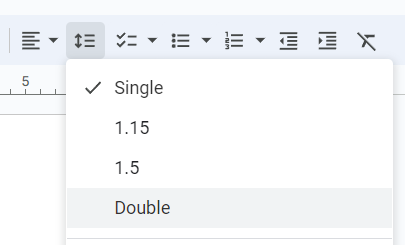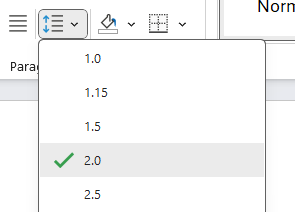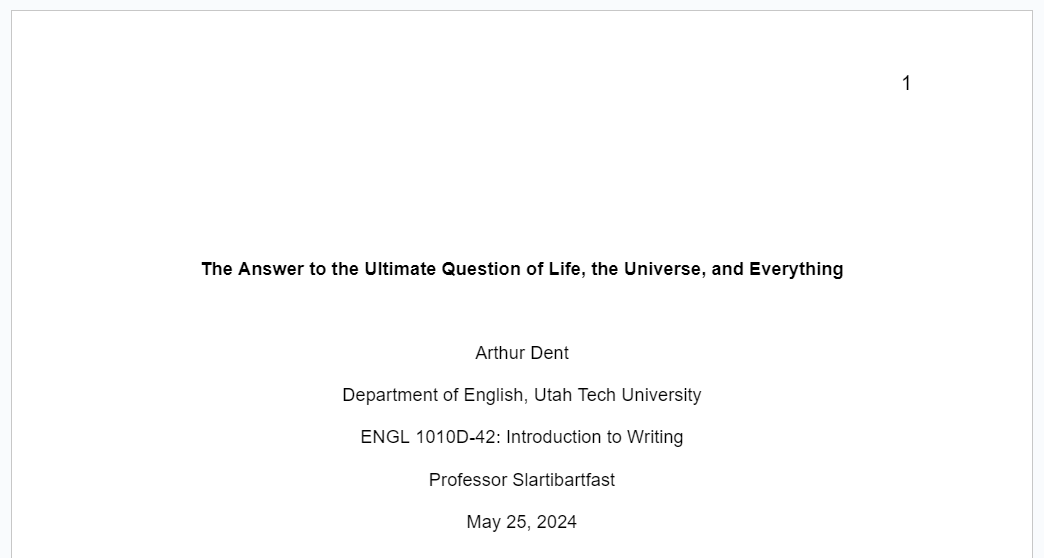28 APA Style
APA style was originally developed by the American Psychological Association. In 1929, some psychologists and other professionals met to discuss the need for a set of style rules to bring greater consistency and transparency to scientific writing. Their seven-page article has evolved over the decades to the current 7th edition Publication Manual with over 400 pages of examples, guidelines, and tips. This style focuses on the currency or recency of the research and on providing uniformity for academic writing so that readers can focus on the ideas and sources that authors have put together for them.
Formatting
The formatting requirements for APA style are both fairly similar to and also different from what MLA asks. Here’s what you need to do to format your paper correctly:
Double spacing
The entire paper should be double spaced starting with the cover page. Just set it up from the very beginning and you won’t have to think about it for the rest of the paper.
It’s fairly simple to double space in both Google Docs and Microsoft Word. In Google Docs, you can click Format → Line & paragraph spacing → Double. You can also click the “Line & paragraph spacing” button and select “Double” there, as well.


In Microsoft Word, click the Line and Paragraph Spacing button and select “2.0,” or you can just type “Ctrl + 2” on the keyboard. If you started typing your paper before double spacing, just make sure that you select the entire paper to apply the formatting everywhere. In both Docs and Words, you can do this by typing “Ctrl + A” to select all before applying the double spacing.
Cover page
Probably the biggest difference between MLA and APA style in terms of formatting is that APA requires the use of a cover page on all papers. This is a separate page from the rest of your essay. Your actual paper should start on the second page. There are a number of required elements that should be present on the cover page.
- Page number – The page numbering starts on the cover page with the number 1. It should appear alone in the header in the top right corner of the page.
- Title – The title should be centered on the cover page and down three or four double-spaced lines below the top of the page.[1] Similar to MLA style, the title should be the same font and size as the rest of the paper. Unlike MLA, however, the title of your paper should be bold. If there’s a subtitle, you can put it on a separate line below the title if you wish, but you can also put it directly after the title, separated by a colon.
- Author’s name – After the title, hit “enter” twice so that there’s a blank line between the title and your name. Your name should also be centered.
- Author’s affiliation – On the next line, center your affiliation. The affiliation is the name of the department of the course you’re in along with the name of the university. For this course, for example, you would write “Department of English, Utah Tech University.”
- Course number and title – On the next line, center the course number and title. Use the course number from the catalog, along with the given title of the course, which you can find in the syllabus or course catalog. Again, for this course, “ENGL 1010D: Introduction to Writing” would be the title to use.
- Assignment due date – The final line of the cover page is the assignment due date, still centered. The APA style guidelines say you can use the date format that is typical for the country you are in. In this class, the full month, day, and year is a good format.

Other pages
On the first page of the body of the essay, start the essay by putting the title at the very top of the page, centered, and in bold. The essay should start on the next line with no extra space between the title and the introduction or between any other paragraphs.

Font and style
APA style doesn’t specify any particular font or size that must be used, though Times New Roman, Calibri, and Arial are all mentioned as acceptable. Font sizes of 11 or 12 points are a good choice for legibility. The default font of your word processor is considered acceptable, no matter which one that is.
Numbers
For APA, the general rule is that you write numbers 0 through 9 as words and anything 10 or larger you write as numbers. There are exceptions to this rule, of course, such as always using numbers for mathematical expressions, to express times and dates, and whenever they appear in front of a unit of measurement, so if you’re in doubt, check out your favorite online resource to get more guidance.
Citations
While MLA style focuses on the author or creator of the work, APA is all about the science. The most important thing in APA style is how old the research is. In scientific research, knowledge progresses and grows as more studies are done and replicated and confirmed or disproved by others. So, while good research was being done 20 years ago, if you’re basing your writing and ideas on what was known back then, you’re going to be missing out on everything that has been learned since then. So, APA keeps its focus firmly on how recently something was published. This is reflected in all the ways you are required to give credit to the authors and the information you need to include with every citation, both in the essay and at the end of your paper.
Again, remember that we’re only going to cover the scant basics in this section. Find an online resource that goes into much greater detail about all the various, nuanced source types so that you can find the answers you need when you need them. I’m a big, uncompensated fan of Purdue’s Online Writing Lab (OWL), but there are other good resources out there, too.
In-text authors
As mentioned earlier, APA is not that interested in the authors or creators of the sources you use. Yes, you need to give the authors their credit, and yes, you use their name to do so, but in APA, you never use the author’s full name. Ever. When referring to the author in the text of your essay, always use their last name.[2] When a source has two authors, use both authors’ last names in the text of your essay joined by “and.” When there are three or more authors, use the first author’s last name and the abbreviation “et al.” with a period after the second word.
Here’s a critical difference between MLA and APA: whenever you mention an author in your paper, their name must be followed by the year when their source was published. Remember when I mentioned that APA is very focused on recency? This is where it shows up. Every author’s name must be followed by the year in parentheses every time you mention them. Here’s what that looks like:
Examples
Adams (2010) uses science fiction as a way to satirize a number of different topics, such as religion and bureaucracy.
Adams and Carwardine (1991) set out to explore far-flung locations in the hopes of finding some of the last remnants of a number of endangered species.
Baek et al. (2020) investigated whether the video game Minecraft could be effectively used as an educational tool.
In-text citations
Whenever you paraphrase or directly quote from a source, you need to provide a citation in the text that tells the reader where this information came from. If you mentioned the author in the text (followed by the year of publication in parentheses), then the only thing you need to put in the citation after the quote or paraphrase is the page number that the quote came from. Always use the abbreviation “p.” (or “pp.” when the information comes from multiple pages) before the page number.
Example
In The Hitchhiker’s Guide to the Galaxy, Adams (2010) satirizes the tech industry and their constant push towards new, pointless features by introducing Marvin, an android with a pre-programmed personality that is manic depressive. At one point, when a human character tries to brush off Marvin’s depressing banter by saying it’s just part of life, Marvin responds with a retort: “Life . . . don’t talk to me about life” (p. 63).
However, if you don’t name the author within the text, then you must put the author’s last name, the year of publication, and the page number all within parentheses after the quote.
Example
At another point, Marvin observes, “Life . . . loathe it or ignore it, you can’t like it” (Adams, 2010, p. 95).
Any time you paraphrase or quote from a source, you must provide all of this information within the text of your paper.
References
For every source mentioned in a citation within your essay, you must have a full citation at the end of your paper. Regardless of whether you quoted from it directly, paraphrased it, or simply summarized it, you need to give your reader all of the information they need to find the source on their own. The APA has set out guidelines that explain how to organize all of this information and how to format it so that there is consistency across different authors within the field of study. Here’s what you need to have for your References page:
- Starts on a new page – The References page always starts on a new page. Even if your essay ends at the very top of a page and you only have one source to document, you always start your References list on the next clean, blank page.
- Title – At the top of the page, put the title “References” in the center. The title should be bold.
- Alphabetized – All citations should be in alphabetical order according to the first thing in the citation.[3]
- Double spaced – Continue the double spacing that you started at the very beginning of your essay.
- Hanging indent – The first line of each citation should be flush with[4] the left margin. If the citation requires more than one line, the rest of the lines should be indented half an inch. This is called a hanging indent. When there are many citations together on the References page, the hanging indent makes the author’s last name—the thing you gave the reader in the essay, which they’ll use to find the full citation—pop out away from the bulk of the text. Here’s what a citation with a hanging indent looks like in APA format:
Example
Adams, D. (2010). The hitchhiker’s guide to the galaxy: Five novels and one story. Harmony Books.
The APA style manual also provides structures and rules for each type of source you might want to use in your paper. As you prepare your citations, make sure you check the template so that you’re assembling your citations correctly. Here’s what a template might look like for a book:
Example
Lastname, F. M. (Year). Title of book: Subtitle of book. Publisher. DOI (if available)
This template tells you that you should begin the citation with the author’s last name, followed by a comma. Next, put the author’s first initial, a period, a space, and then their middle initial and a period (if they use a middle name or initial in their professional writing). In parentheses, put the year of publication, followed by a period after the closing parenthesis. The title of the book comes next, formatted in italics. Notice that the title should not be capitalized using title case. Only the first letter of the title should be capitalized, along with any proper nouns in the title, just like a normal sentence. If there’s a subtitle, put a colon after the title, and format the subtitle the same way. The publisher should be listed next in normal text, followed by a period. For most books, that will be the end of the citation, but if there is a DOI[5] listed, you should include that, too, but plenty of print sources do not have a DOI, so just skip it if it doesn’t exist.
There are many different types of sources, and the APA style manual provides templates for each one. Make sure that you review and follow the template that pertains to the kind of source you cited in your paper. Carefully review date formats to make sure your dates match the expectations of your readers. And finally, one thing you’ll notice about APA style is that there are lots of little fiddly periods and commas you need to use. Check and double check your writing to be certain that you haven’t skipped any.
Below, I’ll provide a few templates and examples for the more common source types that you might use. Remember that we’re only covering the basics and that you’ll need to confer with more comprehensive resources if you need anything beyond what we cover here.
Books
Lastname, F. M. (Year). Title of book: Subtitle of book. Publisher. DOI (if available)
Examples
Adams, D. (1987). Dirk Gently’s Holistic Detective Agency. Pocket Books.
Adams, D., & Carwardine, M. (1991). Last chance to see. Harmony Books.
Websites
The following is the generic template for websites:
Lastname, F. M. (Year, Month Date). Title of page. Site name. URL
If the website belongs to a newspaper with a print version, use the following format:
Lastname, F. M. (Year, Month Date). Title of article. Title of publication. URL
Examples
Starr, M. (2014, March 10). Play the Hitchhiker’s Guide to the Galaxy text adventure. CNET. https://www.cnet.com/tech/gaming/play-the-hitchhikers-guide-to-the-galaxy-text-adventure/
Barnett, D. (2023, September 3). Revealed: How Hitchhiker’s Guide author predicted rise of ebooks 30 years ago. The Guardian. https://www.theguardian.com/books/2023/sep/03/revealed-how-hitchhikers-guide-author-predicted-rise-of-ebooks-30-years-ago
Academic Articles in Scholarly Journals
Lastname, F. M. (Year). Title of article. Title of Periodical, volume number(issue number), pages. DOI (if available)
Examples
Fatima, Z. (2016). Humor, satire, and verbal parody in The Hitchhiker’s Guide to the Galaxy: A relevance theoretic approach. NUML Journal of Critical Inquiry, 14(2), 38-53.
Tanner, E. C. (2018). The algebraic galaxy of simple macroeconomic models: A hitchhiker’s guide. Open Economies Review, 29(1), 177-209.
- Start at the top of the blank page, turn on double spacing, then hit “enter” three or four times. ↵
- This can lead to awkward situations where an author’s last name produces mental images in the reader’s head of, say, a kindly older woman. Then, you might discover later at a great academic conference on games and learning in society (shoutout GLS 9.0!) that, in reality, the author is actually an incredibly cool, middle-aged man with a sweet goatee and earrings. Sorry, S. Barab—my bad. ↵
- Usually the author’s last name. ↵
- Or lined up with. ↵
- Digital Object Identifier. This is a digital registry of published items that aims to make finding sources online much easier. The DOI usually looks like a hyperlink. ↵

